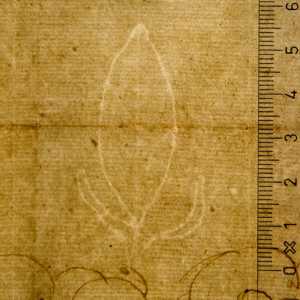Specifications
| Title | Composition Study for 'The Triumph of Sebastiano Venier' |
|---|---|
| Material and technique | Black chalk, pen and brown ink |
| Object type |
Drawing
> Two-dimensional object
> Art object
|
| Location | This object is in storage |
| Dimensions |
Height 279 mm Width 192 mm |
|---|---|
| Artists |
Draughtsman:
Alessandro Maganza
Previously attributed: El Greco |
| Accession number | S 20 (PK) |
| Credits | Loan Stichting Museum Boijmans Van Beuningen (former Koenigs collection), 1940 |
| Department | Drawings & Prints |
| Acquisition date | 1940 |
| Creation date | in circa 1613-1621 |
| Watermark | Fruit or flower bud with two leaves (56 x 29 mm, left of centre, upside-down, on P3 of 7P, vH, cropped folio), subtype not in Briquet or Piccard Online. [see image] |
| Inscriptions | 'Jacopo Tintoretto' (on removed mount, below right, pencil) |
| Collector | Collector / Franz Koenigs |
| Mark | F.W. Koenigs (L.1023a on removed mount) |
| Provenance | Sir Archibald Alison (1792-1867), Glasgow (in an album); art dealer Luigi Grassi (1858-1937, L.1171b), Florence (from the album, probably dismembered by him); Franz W. Koenigs (1881-1941, L.1023a), Haarlem, acquired in 1930 (attributed to El Greco); D.G. van Beuningen (1877-1955), Rotterdam, acquired with the Koenigs Collection in 1940 and donated to Stichting Museum Boijmans Van Beuningen |
| Exhibitions | Venice/Florence 1985, no. 52; Rotterdam 2009 (coll 2 kw 2) |
| Research |
Show research Italian Drawings 1400-1600 |
| Literature | Tietze/Tietze-Conrat 1944, pp. 27, 292 under no. A 1754 and A 1757 (mid 17th-c.); Wethey 1962, p. 153 (Venetian Mannerist); Byam Shaw 1976, under no. 840; Byam Shaw 1983, under no. 252; Aikema/Meijer 1985, no. 52, ill.; Paris 1996, under no. 61; Meijer 2017, pp. 262-63, 265, fig. 15 (Alessandro?) |
| Material | |
| Object | |
| Geographical origin | Italy > Southern Europe > Europe |
| Place of manufacture | Vicenza > Veneto region > Italy > Southern Europe > Europe |
Do you have corrections or additional information about this work? Please, send us a message

























